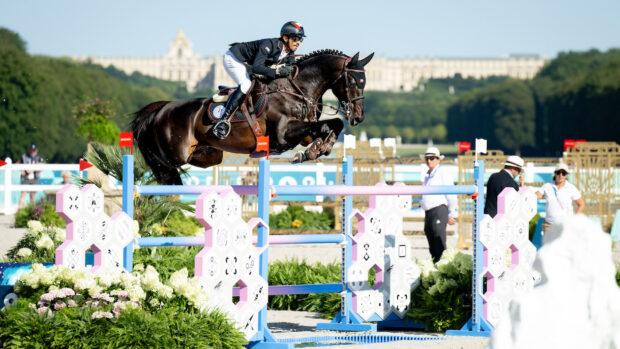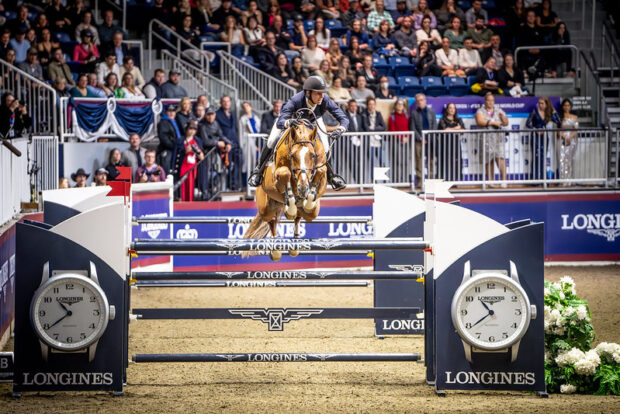Every weekend, as amateur show jumpers across Britain load their horses to head for another show, riders all over the world are doing likewise. While our national system has seen the arrival of age classes dominated by professionals and smaller courses for weekend competitors, other countries have honed their own individual strategies.
France
- Show jumping is the most popular discipline in France, with more than 25,000 riders holding licences to compete.
- Amateurs must pass a basic riding test to gain a licence.
- Horses and ponies must be microchipped, vaccinated and hold a passport, which costs 107 (£73.50) for a pony and 198 (£136) for a horse. The passport must be revalidated every four years.
- Classes for amateurs range from 0.90m to 1.20 grand prix
- Young horse classes: style and performance for four-year-olds; five-year-olds jump two rounds across two days; six-year-olds jump off on the second day
- Young horse courses become progressively more difficult as the season progresses
Germany
- Around 86,195 riders hold a jumping licence, for which they pay 30-54euro (£20-£37) per year according to the height at which they wish to compete.
- All riders belong to an affiliated club and must pass a dressage test to obtain their jumping licence .
- The German system operates on points awarded to riders, not horses.
- Young horse classes for five- and six-year-olds are judged entirely on style.
- For a good style mark, a five-year-old horse will win 50-60euro (£34-£40).
- Amateurs compete over the same courses as professionals but have separate prizes.
- Entry fees for M, A and L classes range from 10-15euro (£7-£10).
- 5,600 national shows are run; some combined with dressage.
Hong Kong
- The Hong Kong Equestrian Federation looks after one of the world’s smallest show jumping communities. There are 335 horses registered and 55 show days. These figures include dressage and eventing, and most horses take part in all three disciplines.
- Pre-novice classes start over 0.75cm through to a 1.05m open. Popular competitions include hit and hurry, fault and out and speed and handiness. The latter, jumped against the clock, involves alternative obstacles marked only by the direction in which they should be jumped. Competitors can save time by jumping more difficult fences.
India
- In India, it isn’t unusual for show jumping to be run alongside another affiliated discipline — tent pegging.
- Classes range from preliminary at 0.80m-1m to grade I (up to 1.40m).
- Horses are graded on points according to faults rather than results. Eliminations or 20+ faults incur two minus points, so a series of poor performances can mean a downgrade.
- No horse may jump more than two rounds on each competition day.
Ireland
- The Show Jumping Association of Ireland runs 1,200 show days and has 7,000 rider members.
- Registration costs 85euro (£58) per year for seniors and 40euro (£27) for juniors.
- Age classes for five, six and seven year olds are similar to Britain. There are some style and performance classes for four-year-olds and loose jumping for three-year-olds.
- Shows tend to stop during the winter due to a lack of indoor venues.
- A new rule means that all horses registered for the first time this year must be microchipped. This has applied to ponies for the past two years to help monitor identity and height.
New Zealand
- New Zealand has 3,175 registered jumping riders and runs 70 shows per year, ranging from one to four days.
- Horse registration costs NZ$105 (£35), entry fees are NZ$5-100 (£1.50-£33) per class and first prize for a 1.10m class might be NZ$40 (£13).
- Four-year-olds have limited outings, five-year-olds jump 1.05m-1.20m, six-year-olds 1.10-1.25m and horses aged seven jump 1.25m-1.40m. With no grading system, riders normally enter height classes corresponding to their horse’s age. There are also pony classes.
- Early-season shows run training rings at 0.90m-1.05m.
- With only one indoor centre in the country, there are virtually no shows for seven months of the year
South Africa
- The Eastern Cape Horse Society, one of five autonomous regions that comprise the South African National Equestrian Federation, runs 124 days of show jumping for its 224 members.
- Annual membership costs SAR300 (£25), horse registration SAR100 (£8) and entry fees for local shows average SAR40 (£3).
- Novice classes start over tracks up to 0.60m with grading based on horses’ ages. There are also pony classes. Most shows take place at centres.
- At training shows, riders can enter at a height from 0.60m to 1.20m.
Sweden
- Some 23,000 riders are licensed to compete by the Swedish Equestrian Federation, of whom about 75% are show jumpers. A senior licence costs 80euro (£54) per year, and a junior licence 50euro (£34).
- The federation runs 1,200 shows per year, including dressage competitions. There are no unaffiliated shows
- Up to the age of seven horses compete in age classes, aiming for clear rounds over tracks of up to 1.30m
- Horses and riders are graded on points as a combination, which allows novice riders to buy an experienced horse and progress gradually up the grades.
Switzerland
- Switzerland has 7,062 licenced show jumping riders competing at 385 affiliated shows.
- A regional licence to compete at smaller shows costs SFR121.20 (£53.60), while the licence for bigger shows costs SFR202.20 (£89.50).
- Amateurs have to pass dressage test of increasing difficulty to compete in classes up to 1.25m in height
- Shows for amateurs and young horses are kept separate from larger classes
- Training shows are popular with tracks set at 1.10m, 1.20m and 1.30m. Riders get 2min each in the ring with people on hand to alter fences
United States
- Around 7,000 members of the United States Equestrian Federation list jumping as their “primary discipline”; another 8,000 have it as their “secondary discipline”.
- Horse registrations cost $75 (£40) per year and membership is $110 (£58).
- Most American shows run for five days, often back to back across two weeks, Professionals jump in the week, with amateur classes and grand prix at the weekend
- Pony jumper classes are open to riders up to the age of 18, stallions are prohibited and style awards must be given at shows running three or more pony classes. Jumping against the clock on ponies is discouraged; often, only the final day’s championship is decided by a jump-off.
- Age classes have been introduced. Four-year-olds jump clear rounds, five-year-olds jump to an optimum time and six-year-olds jump off.
|
||
 |
||

 Get up to 19 issues FREE
Get up to 19 issues FREE TO SUBSCRIBE
TO SUBSCRIBE 


